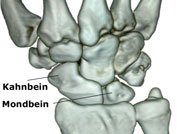
Thumb pain and wrist pain are frequently complained of by patients in hand surgery. There are many possible causes and differential diagnoses. The most important causes of thumb pain are presented below:
Thumb pain is the main symptom of rhizarthrosis.
Rhizarthrosis, also known as thumb saddle joint arthrosis, usually manifests itself as load-dependent pain at the transition from the thumb (1st metacarpal bone) to the wrist. It is one of the most common causes of thumb pain.
Tenosynovitis near the thumb
Tendovaginitis can also lead to pain in the thumb if the corresponding tendons are affected. Tendovaginitis de Quervain (housewife’s thumb) and tendovaginitis stenosans (snapping thumb) can be particular forms or consequences of tendovaginitis:
- In tendovaginitis de Quervain, the pain predominantly affects the base of the extensor side of the thumb. The pain extends from the forearm-wrist area on the thumb side to the thumb.
- In the case of snapping thumb / tendovaginitis stenosans, the pain is localized on the flexor side of the metacarpophalangeal joint of the thumb.
The ganglion can also be a cause of thumb pain.
The ganglion / ganglion on the thumb can also cause pain. As the ganglion is usually found on the extensor side, the main pain also occurs here. Smaller ganglions can also be located on the ring ligament on the flexor side. These can lead secondarily to a narrowing of the annular ligament (annular ligament stenosis) and end in the so-called snapping thumb. Overall, however, ganglions are a very rare cause of thumb pain.
Thumb pain as a result of injuries.
Thumb pain is often associated with injuries such as fractures, strains, bruises, ligament injuries and others. The treatment depends on the injury in question. The basic principles are Immobilization, cooling, elevation, pain therapy and decongestant measures, etc. Even with a minimal strain and adequate treatment, the pain in the thumb can remain for months.
- Older injuries:
Injuries can lead to renewed pain in the thumb even after many years. If a fracture has healed in the wrong position or in the event of incorrect strain due to a torn ligament, premature wear and tear can lead to osteoarthritis and pain in the thumb. - Ski thumb – rupture of the ulnar collateral ligament:
The ski thumb is usually caused by the thumb getting caught on the ski pole strap during a fall. This results in a tear or partial tear of the ligament on the little finger side of the metacarpophalangeal joint of the thumb with corresponding pain. In the case of a complete tear, surgery is performed to prevent thumb instability. - Overuse pain:
Thumb pain can also be observed without an acute injury due to chronic overuse of the thumb. The causes can be occupational or sporting in nature. In this case, recurring irritation (repetitive injury) of the joint or neighboring structures due to micro-injuries triggers the pain in the thumb. The triggering cause (certain activities) should then be avoided. Treatment can also be carried out as described in the ‘Injuries’ section.
Pain with osteoarthritis of the thumb
Osteoarthritis is a wear-and-tear disease that initially shows up on X-rays as calcium deposits, cartilage atrophy and later without a joint space with bone deposits and cysts. The severity of the pain in the thumb varies greatly from person to person. The most common arthrosis of the thumb is rhizarthrosis.
Other forms are osteoarthritis of the metacarpophalangeal joint of the thumb and osteoarthritis of the distal joint of the thumb. The pain can be found in the respective thumb joint and is more pronounced with strain and changes in the weather. If conservative treatment is no longer sufficient, surgery is an option. Stiffening is usually performed on the thumb end joint and base joint. At the thumb saddle joint, the joint is replaced with autologous tissue or an implant.
Chronic polyarthritis and other forms of arthritis
- Chronic polyarthritis is a systemic disease that usually begins with pain, swelling and restricted movement in small joints. If thumb pain is unclear, it should be ruled out by a rheumatologist.
- Reactive arthritis can be caused by infections of the intestines or urinary tract (Reiter’s syndrome), whereby no germs but antigens of the germs are detectable in the affected joint. Such arthritis can also affect the thumb with pain, swelling and overheating.
- In infectious, bacterial arthritis, germs can be detected in the affected joint. In addition to pain, swelling and overheating, fever is also one of the symptoms.
- There are other joint inflammations = arthritis and rheumatic diseases that can be accompanied by pain in the joints, including the thumb. However, several joints are usually affected.
Pain with special bone diseases of the wrist
Various bone diseases can lead to thumb pain:
- Bone cysts:
Bone cysts on the thumb, such as enchondromas, which consist of cartilage tissue in the bone, can also make themselves felt through pain. This is particularly the case if a sharp increase in size has led to a fracture or break in the bone. Bone cysts should therefore also be ruled out with the help of an X-ray examination in the event of unclear thumb pain.
Scaphoid necrosis (also known as scaphoid malacia, Preisler’s disease):
Scaphoid necrosis is a hand disease of unknown cause in which a circulatory disorder leads to reduced blood supply and thus to the slow death of the scaphoid bone. Although pain in the thumb-side area of the wrist is typical here, it can radiate into the thumb.
Gout as a cause of thumb pain
Gout (hyperuricaemia) and pseudogout (chondrocalcinosis) can also cause pain in the thumb. In the case of gout, which is caused by uric acid deposits, the metacarpophalangeal joint of the thumb is the main site of pain, along with the metatarsophalangeal joint of the big toe. However, the ankle joint, knee joint and other joints can also be affected. In pseudogout, special calcium crystals are deposited and usually cause pain in the knee joint. The thumb is rarely affected.


